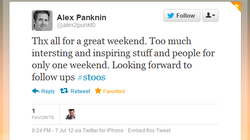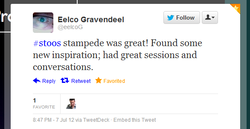The fifth view of the Management 3.0 model is about information paths and organizational structure.…
Stoos Stampede: Energize People (1/6)
The original “Stoos 21” selected Amsterdam and 6+7 July for the next event of the Stoos Network. And then I stepped forward to try and make it happen by being a Management 3.0 leader…
From Closed to Open
I said I would only participate in a next event if it was open for anyone to join. In January we got clear feedback that people wanted to be part of our conversations. And where there’s passion and energy, you must facilitate it. And so the idea of a “stampede” was born. (The cool name was Melina’s suggestion.) And I started looking for a venue.
I decided to focus exclusively on the people who wanted to come to Amsterdam. Some of the original “Stoos 21” were reluctant, skeptic, or silent. And that’s OK. But right from the start I only wanted to invest my time and energy in people seeking to satisfy their needs for curiosity (“what is this stampede?”), relatedness (“ooh, I want to be part of that”), and purpose (“let’s change the world!”).
Risk Management
 One thing I had to do was find partners to carry the risk of the event. What if we didn’t find enough sponsors? What if we didn’t get enough registrations? Someone had to guarantee the event would take place.
One thing I had to do was find partners to carry the risk of the event. What if we didn’t find enough sponsors? What if we didn’t get enough registrations? Someone had to guarantee the event would take place.
So I called Laurens Bonnema of Agile Holland and Patrick Verheij of Agile Consortium. I said my aim was to get more than 100 people together, many of them traveling from all over the world, to discuss organizational transformation. I argued, surely the leading Agile communities of The Netherlands would want to play the host for this great gathering and make sure Holland reinforces its positive image in the world? It is clear I played the honor card here (“let’s satisfy and exceed people’s expectations”). We quickly agreed that we would share the financial risk of the event between the three of us, thereby making sure the organizers could move forward.
Team
 The organizing team of Melina, Erwin, Wouter and Astrid formed organically over time. If you want to know what motivated me and the others, you will need to ask us individually. Maybe some of our motivators were power (“by doing this I can make a difference”), freedom (“let’s do this thing my way”), order (“let’s make sure it’s not a mess”), or status (“yay, I’m the organizer of the first stampede ever!”).
The organizing team of Melina, Erwin, Wouter and Astrid formed organically over time. If you want to know what motivated me and the others, you will need to ask us individually. Maybe some of our motivators were power (“by doing this I can make a difference”), freedom (“let’s do this thing my way”), order (“let’s make sure it’s not a mess”), or status (“yay, I’m the organizer of the first stampede ever!”).
Or maybe it was curiosity, honor, relatedness, or any of the other 10 intrinsic desires that drove the team members. It doesn’t matter. What matters is that work was done by the ones who liked doing it. And what we didn’t like, simply wasn’t organized (such as stuffing conference bags with crap).
Energize People
The first view of Management 3.0 is Energize People. Smart managers understand you get the best results when you adapt work and responsibilities to people’s intrinsic motivation. Not the other way around.
Go and read the Stoos Stampede Story…
See also:







